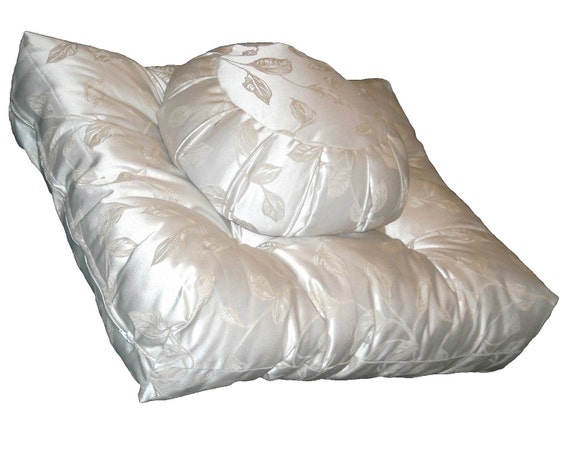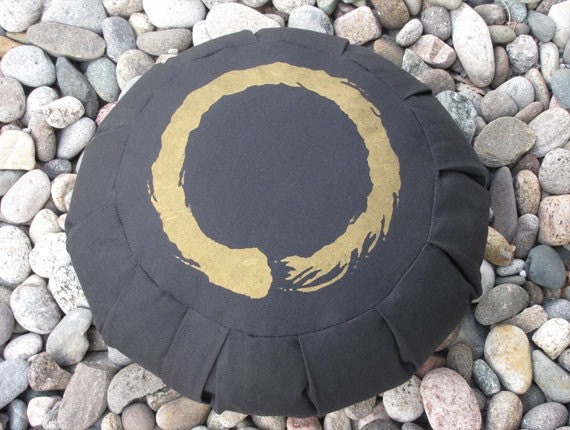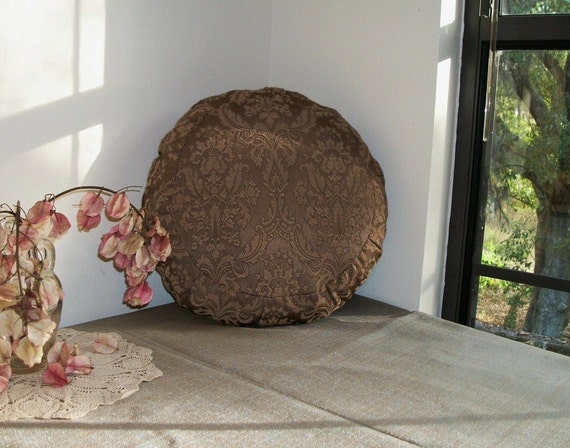The Zafu

Courtesy DharmaNet.org
"Zafu" is written with two Japanese kanji: "za," meaning "sitting," and "fu," referring to cattail or reedmace, the original stuffing material (rarely used in zafus today). Often, though, it's translated as "sewn seat" or something similar. Online, I've seen zafus in all kinds of colors and patterns, but the ones my sangha uses are black.
The Zabuton

Courtesy of ZafuStore.com
Unlike the zafu, which is associated primarily with zazen meditation, the zabuton has many everyday uses. It's the standard cushion for floor seating, though in zazen you don't sit on the zabuton. In zazen, you place the zafu on top of the zabuton, using the zafu to cushion your pelvis and the zabuton to cushion your ankles and knees. This is especially important when you're doing zazen on a hardwood floor! Keeping the pelvis elevated is important for comfort and good zazen posture, which is why you don't simply sit on the zabuton itself.
Where To Get Your Zafu
Of course, there are a variety of shops on Etsy that sell zafus, zabutons, and entire sets!
Light Mine Studios has customizable sets and single zafus in an assortment of sizes and luxurious fabrics:

Large Customizable Zafu Set
InspiraZen also carries lovely sets, with exceptional hand-printed designs:
 Enso Zafu
Enso ZafuA nice compromise between buying and making yourself is buying the cover and then stuffing it on your own. Stuffing anything like a pillow or toy animal can take more time than you imagine; by selling only the cover, an artisan can provide a high quality product and keep the price very economical, since they no longer need to charge for the filling material or the time spent stuffing the zafu. ZafuChi has a variety of zafu covers for sale, all at a very budget-friendly price. And they're beautiful as well:

Mocha Jacquard Zafu Cover
But for those aspiring seamstresses and tailors out there, why not go whole hog? Making your own zafu (as well as zabuton, if you're feeling ambitious) can be a meditative process in itself, and a way of demonstrating devotion. Plus, the things we make, we imbue with a little bit of ourselves and our wills; they are by nature more meaningful for us than things we simply buy.
How To Make Your Zafu
(The part you were all waiting for ;])
The definitive guide to making a zafu was published in a now out-of-print text by John Daishin Buksbazen called "To Forget the Self: An Illustrated Guide to Zen Meditation." Fortunately, it's been immortalized in the Internet. You can find instructions at MichiganBuddhist.com, or with the original diagrams at FineCraftGuild.com. I suggest bookmarking one of those and embarking on the zafu craft during your next rainy weekend.
The Filling
Most zafu retailers stuff their cushions with either buckwheat or kapok; some use cotton. Polyfill is also popular. What you prefer is a question of comfort, price, and environmental concern.
1. The Environment
The cheapest and easiest-to-acquire filling is the workhorse cotton. Unfortunately, conventionally-grown cotton uses more insecticide than any other crop in the world, and is also more water-dependent than your other filling options. (Source: The Organic Trade Association) If you are concerned with your environmental impact, cotton shouldn't be your first choice.
Polyfill/polyester is also common. As a synthetic it requires an non-renewable investment in energy, though recycled polyester filling is also available.
Kapok is a light, downy filling from the Ceiba (pronounced say-ba) tree found in Asia and Central America. It's a hardy, fast-growing tree; kapok is the substance that surrounds the Ceiba seed. In its finished form, kapok is a light, silky filling similar to down, though hypoallergenic. (Source: Organic.org) From an environmental perspective, it's preferable to cotton because it's naturally more pest-resistant; unlike polyester, it's renewable. However, it's not a naturally occurring tree in the US or Canada, so it will eat up some fossil fuels in transportation to the US.
Buckwheat grows naturally in the northern US and Canada and offers the same environmental benefits as kapok: it's a hardy, pest-resistant plant, and it grows very quickly. For practitioners living in the contiguous United States or Canada, it's a bit more of a sustainable choice through the reduced fuel cost in shipping.
2. Cost
Cotton is the cheapest, available for about a dollar a pound. Polyester is about two dollars a pound. Buckwheat is three-four dollars a pound, and kapok is the most expensive at six dollars per pound.
3. Comfort
Everyone has a different body and different preferences about seating. Cotton, polyester, and kabok are lighter and are going to be softer and more yielding; buckwheat is firmer, with more resistance. If possible, you should try all of your options see which you prefer—it's difficult to make it through zazen if you are extremely uncomfortable! I personally prefer a buckwheat zafu, as it resists compression over the duration of the zazen session.
4. Other Notes
Whatever you choose to use inside your zafu, you should remember that anything you use will compress over time and eventually need to be re-stuffed (which is why including a zipper is such a good idea). So be generous with the stuffing and make sure you get material into every nook and cranny.
I haven't been ambitious enough to make my own zafu yet—I'm working on developing my sewing chops—but it's on my list, since regular pillows just aren't cutting it anymore. If you've made your own, let's see it in the comments!
Great article, and information for DIYourselfers!
ReplyDeleteThank you for including a picture/links of one of my Zafu Covers.
Sarah,
EclecticArmadillo.etsy.com
Very interesting article! You've got me thinking about making a knitted version already. :)
ReplyDeleteOooh, I bet a knit one would be super comfy!
ReplyDeleteThanks for an interesting article.
ReplyDeleteI decided to get a set for myself. After search several sites, I bought my set from http://www.zafustore.com, which the author mentioned above. I found that they have a affordable and comfortable set. Their zabuton is so soft and comfortable. The zafu is nice and has solid support. The fabric is durable and high quality. Thank you.
Thanks for the recommendation, John! I have no experience with zafustore.com so that's helpful to know.
ReplyDeleteI love the cushions you have featured here - I think our family needs some better meditation cushions, so these provide food for thought...
ReplyDelete